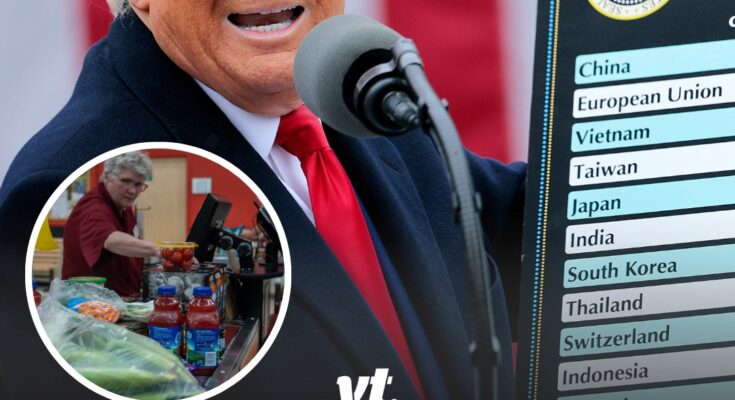US shoppers have been urged to buy 10 essential items before prices skyrocket after Donald Trump‘s imposed tariffs.
Following Donald Trump’s explosive “Liberation Day” announcement on April 2, a sweeping set of global tariffs is poised to make everyday items more expensive across the board — and experts are urging Americans to take action fast.
The 47th President returned to the White House in January and has wasted no time reshaping US trade policy.

This week, he revealed that a 10% “baseline” tax will now apply to all imports — with much higher rates for 60 countries he’s dubbed the “worst offenders”.
That includes Japan (24%), South Africa (30%), and Vietnam (46%). But the biggest target? China, which got hit with a staggering 54% tariff on imports into the US.
“This is Liberation Day,” Trump declared during a dramatic Rose Garden address.

He continued: “We’ve been waiting for a long time. April 2, 2025, will forever be remembered as the day American industry was reborn, the day America’s destiny was reclaimed, and the day that we began to ‘Make America Wealthy Again’.”
“For decades our country has been looted, pillaged, raped and plundered from nations, near and far, from both friend and foe alike.”
“They do it to us, and we do it to them. Doesn’t get much simpler than that.”
The economic fallout hit almost immediately. US stocks tanked — the S&P 500 lost $2 trillion in market capitalization, and the US dollar hit a six-month low.
Experts are now warning that the impact will be felt at checkout counters everywhere.
Per the Mirror, among the items expected to spike in price:
- Bananas
- Avocados
- Coffee
- Tea
- Cars
- Furniture
- Washers
- Dryers
- Clothes
- Toys

Many of these products are imported from countries now facing stiff new tariffs, making them more expensive for US consumers.
That’s why shoppers are being told to act now — especially if they’re in the market for big-ticket items like home appliances or cars.
Things didn’t stay one-sided for long. On April 4, China struck back, announcing a 34% tariff on all U.S. goods starting April 10 — and Trump didn’t hold back.
“CHINA PLAYED IT WRONG,” he wrote on Truth Social. “THEY PANICKED – THE ONE THING THEY CANNOT AFFORD TO DO!”
China had already slapped 15% tariffs on US coal and liquefied natural gas, and 10% on crude oil, agricultural machinery, and large-engine vehicles.

Now, China has filed a complaint with the World Trade Organization (WTO), calling Trump’s tariffs illegal and damaging.
“The United States’ imposition of so-called ‘reciprocal tariffs’ seriously violates WTO rules,” China’s commerce ministry stated.
“It is a typical unilateral bullying practice that endangers the stability of the global economic and trade order. China firmly opposes this.”
China also announced new export controls on rare earth materials — key components used in smartphones, electric vehicle batteries, and high-end electronics.
The full list of tariffs:
- China: 34% (Rising to 54% with other tariffs)
- European Union: 20%
- Vietnam: 46%
- Taiwan: 32%
- Japan: 24%
- India: 26%
- South Korea: 25%
- Thailand: 36%
- Switzerland: 31%
- Indonesia: 32%
- Malaysia: 24%
- Cambodia: 49%
- United Kingdom: 10%
- South Africa: 30%
- Brazil: 10%
- Bangladesh: 37%
- Singapore: 10%
- Israel: 17%
- Philippines: 17%
- Chile: 10%
- Australia: 10%
- Pakistan: 29%
- Turkey: 10%
- Sri Lanka: 44%
- Colombia: 10%
- Peru: 10%
- Nicaragua: 18%
- Norway: 15%
- Costa Rica: 10%
- Jordan: 20%
- Dominican Republic: 10%
- United Arab Emirates: 10%
- New Zealand: 10%
- Argentina: 10%
- Ecuador: 10%
- Guatemala: 10%
- Honduras: 10%
- Madagascar: 47%
- Myanmar: 44%
- Tunisia: 28%
- Kazakhstan: 27%
- Serbia: 37%
- Egypt: 10%
- Saudi Arabia: 10%
- El Salvador: 10%
- Côte d’Ivoire: 21%
- Laos: 48%
- Botswana: 37%
- Trinidad and Tobago: 10%
- Morocco: 10%
- Algeria: 30%
- Oman: 10%
- Uruguay: 10%
- Bahamas: 10%
- Lesotho: 50%
- Ukraine: 10%
- Bahrain: 10%
- Qatar: 10%
- Mauritius: 40%
- Fiji: 32%
- Iceland: 10%
- Kenya: 10%
- Liechtenstein: 37%
- Guyana: 38%
- Haiti: 10%
- Bosnia and Herzegovina: 35%
- Nigeria: 14%
- Namibia: 21%
- Brunei: 24%
- Bolivia: 10%
- Panama: 10%
- Venezuela: 15%
- North Macedonia: 33%
- Ethiopia: 10%
- Ghana: 10%
- Moldova: 31%
- Angola: 32%
- Democratic Republic of the Congo: 11%
- Jamaica: 10%
- Mozambique: 16%
- Paraguay: 10%
- Zambia: 17%
- Lebanon: 10%
- Tanzania: 10%
- Iraq: 39%
- Georgia: 10%
- Senegal: 10%
- Azerbaijan: 10%
- Cameroon: 11%
- Uganda: 10%
- Albania: 10%
- Armenia: 10%
- Nepal: 10%
- Sint Maarten: 10%
- Falkland Islands: 41%
- Gabon: 10%
- Kuwait: 10%
- Togo: 10%
- Suriname: 10%
- Belize: 10%
- Papua New Guinea: 10%
- Malawi: 17%
- Liberia: 10%
- British Virgin Islands: 10%
- Afghanistan: 10%
- Zimbabwe: 18%
- Benin: 10%
- Barbados: 10%
- Monaco: 10%
- Syria: 41%
- Uzbekistan: 10%
- Republic of the Congo: 10%
- Djibouti: 10%
- French Polynesia: 10%
- Cayman Islands: 10%
- Kosovo: 10%
- Curaçao: 10%
- Vanuatu: 22%
- Rwanda: 10%
- Sierra Leone: 10%
- Mongolia: 10%
- San Marino: 10%
- Antigua and Barbuda: 10%
- Bermuda: 10%
- Eswatini: 10%
- Marshall Islands: 10%
- Saint Pierre and Miquelon: 50%
- Saint Kitts and Nevis: 10%
- Turkmenistan: 10%
- Grenada: 10%
- Sudan: 10%
- Turks and Caicos Islands: 10%
- Aruba: 10%
- Montenegro: 10%
- Saint Helena: 10%
- Kyrgyzstan: 10%
- Yemen: 10%
- Saint Vincent and the Grenadines: 10%
- Niger: 10%
- Saint Lucia: 10%
- Nauru: 30%
- Equatorial Guinea: 13%
- Iran: 10%
- Libya: 31%
- Samoa: 10%
- Guinea: 10%
- Timor-Leste: 10%
- Montserrat: 10%
- Chad: 13%
- Mali: 10%
- Maldives: 10%
- Tajikistan: 10%
- Cabo Verde: 10%
- Burundi: 10%
- Guadeloupe: 10%
- Bhutan: 10%
- Martinique: 10%
- Tonga: 10%
- Mauritania: 10%
- Dominica: 10%
- Micronesia: 10%
- Gambia: 10%
- French Guiana: 10%
- Christmas Island: 10%
- Andorra: 10%
- Central African Republic: 10%
- Solomon Islands: 10%
- Mayotte: 10%
- Anguilla: 10%
- Cocos (Keeling) Islands: 10%
- Eritrea: 10%
- Cook Islands: 10%
- South Sudan: 10%
- Comoros: 10%
- Kiribati: 10%
- São Tomé and Príncipe: 10%
- Norfolk Island: 29%
- Gibraltar: 10%
- Tuvalu: 10%
- British Indian Ocean Territory: 10%
- Tokelau: 10%
- Guinea-Bissau: 10%
- Svalbard and Jan Mayen: 10%
- Heard and McDonald Islands: 10% (these are uninhabited)
- Réunion: 37%


